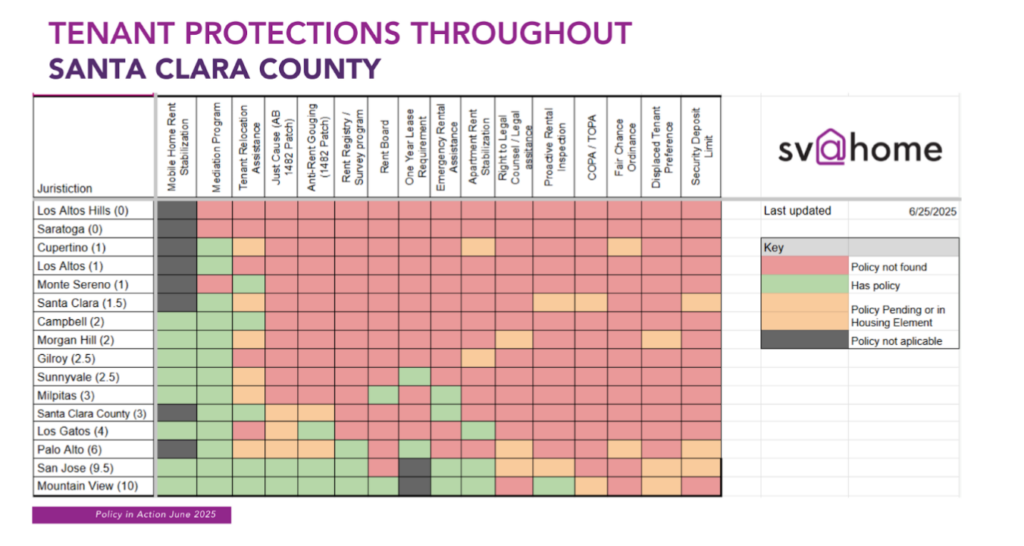Tenant protections in Housing Elements are vital for preventing displacement and meeting California’s AFFH goals. Many cities are exploring programs and policies such as displaced tenant preferences and relocation assistance ordinances. These measures can be powerful but require clear reporting in the Annual Progress Reports (APRs) and strong community oversight to ensure they deliver real stability for renters.

Tenant protections are a critical part of local Housing Elements, serving as key tools to prevent displacement and homelessness. They are also linked to the state’s Affirmatively Furthering Fair Housing (AFFH) obligations. In 2021, the California Department of Housing and Community Development (HCD) issued guidance encouraging cities to include meaningful tenant protection measures in their Housing Elements.
The Housing Element is an eight-year plan created by each California jurisdiction to meet the housing needs of all residents and accommodate future growth. The process is not just about housing numbers—it is an opportunity to center the voices of those most affected by the housing crisis. Community organizing, outreach, and participation during Housing Element development are essential for ensuring that policies address real needs on the ground.
In San José, tenant protections listed in the Housing Element were strengthened through consistent meetings between city staff and the Anti-Displacement Convening Group. This group included tenant advocates, community-based tenant organizations, and legal aid groups. Together, they identified gaps in tenant protection policies and enforcement, elevated best practices from peer cities, and co-designed solutions.
One major outcome was the creation of Housing Element Program S-1: Tenant/Landlord Resource Centers + Code Reporting. This program takes a multi-pronged approach: expanding access to fixed and mobile resource centers, integrating code enforcement violation reporting, supporting tenant associations, and fostering collaborative problem-solving between tenants, landlords, and the city. However, it also could be considered a “frankenprogram”, which is an ambitious, multi-pronged initiative that combines multiple policy actions into a single program. While this type of program can be powerful, it also poses challenges. Different cities use varying definitions for “programs,” “policies,” and “actions,” making it hard to track implementation. In Annual Progress Reports (APRs), complex programs sometimes receive vague updates or have actions skipped entirely. A long-term solution would be to standardize program formats, especially for APR reporting, to ensure transparency and accountability.
Palo Alto offers a strong example of clear APR reporting for a “frankenprogram.” Their update reads:
“In Progress. A security deposit limit of 1.5x of monthly rent was adopted by the City Council in 2023. Just cause eviction protections were enacted by the City Council in 2023. The City’s Rental Registry Program implementation began in 2024. Staff will receive additional direction on a potential Fair Chance Ordinance in April 2025.”
There are many reasons why this city was able to give a succinct yet effective report on many policies. Palo Alto had been working on these policies as early as 2017 and they also participated in the Partnership for the Bay’s Future program, which unlocked financial and staff resources for the work.
Many cities are exploring or expanding tenant relocation assistance ordinances. These ordinances provide financial or logistical support to tenants who are evicted through no fault of their own, often going beyond what state law requires. Cities with TRAO programs in their Housing Elements include Sunnyvale, Cupertino, Santa Clara, Milpitas, Morgan Hill, and Palo Alto. In several of these cities, some form of relocation assistance already exists (along with state protections given by the Tenant Protection Act of 2019), and the Housing Element process provides an opportunity to strengthen those protections.
An emerging trend in this Housing Element cycle is the exploration of displaced tenant preference policies, which give tenants who are forced to move due to redevelopment, code enforcement, loss of affordability restrictions, or natural disasters, priority access to new affordable housing units. While most cities already have a live/work preference, displacement preference ensures that residents can remain in their communities after losing their homes. Cities with this policy in their Housing Elements include San José, Morgan Hill, Mountain View, and Cupertino.
Tenant protections in the Housing Element are more than just policy commitments—they are lifelines for residents at risk of displacement. The examples from San José and Palo Alto show how collaborative processes and clear reporting can turn ambitious plans into real protections. At the same time, emerging trends like displacement preferences and relocation assistance point toward a growing regional focus on tenant stability. Cities can look to each other on many of these anti-displacement policies to seek best practices.
As these programs move from paper to practice, community members and advocates must watch Annual Progress Reports closely and push for clear, measurable updates to ensure cities follow through on their commitments.
